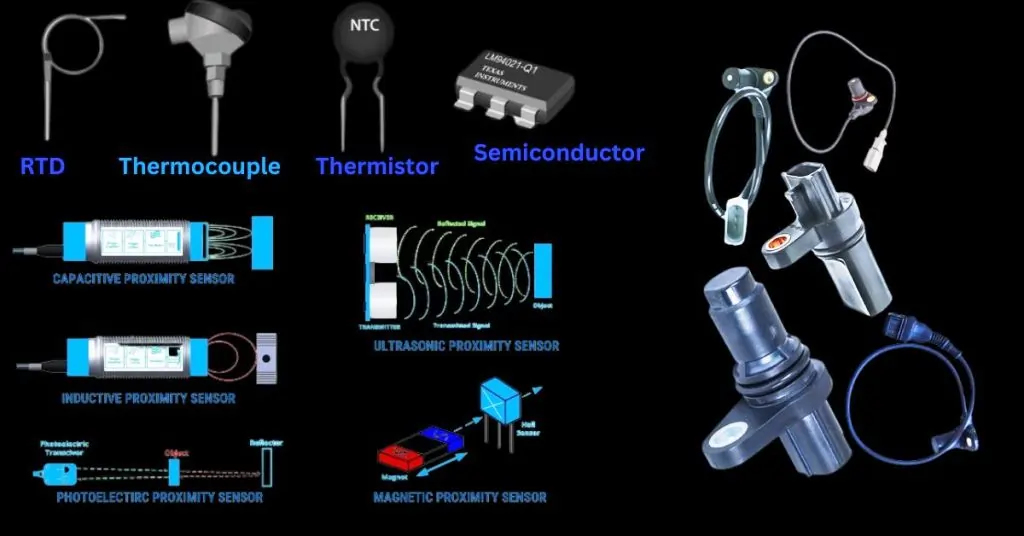Sensors Revolution
Sensor play a pivotal role in today’s technology, seamlessly integrating into various industries to enhance efficiency, accuracy, and safety. These devices detect and respond to physical changes, converting them into signals for monitoring and control. From measuring vital signs in medical devices to ensuring optimal performance in industrial automation, sensors are indispensable.
In 2024, the significance of sensors is more pronounced than ever. The latest advances promise to revolutionize how we interact with our environment. Innovations in temperature, pressure, motion, and chemical sensors are set to drive substantial improvements in consumer electronics, automotive systems, and environmental monitoring. These cutting-edge developments not only push the boundaries of what is possible but also pave the way for smarter, more responsive technologies. In this post, we’ll delve into the top 10 must-know advances in sensor technology for 2024, showcasing the transformative potential they hold for various sectors.
Definition of Sensor
| Aspect | Description |
|---|---|
| What is a Sensor? | A sensor is a device that detects and responds to some type of input from the physical environment. |
| Types of Inputs | Description |
| Light | Detects variations in light intensity and can be used in cameras, light meters, and various light-sensitive applications. |
| Heat | Measures temperature changes and is used in thermometers, thermostats, and temperature monitoring systems. |
| Motion | Senses movement and is commonly found in motion detectors, accelerometers, and gyroscopes. |
| Moisture | Detects humidity and moisture levels, essential for weather stations, agricultural sensors, and indoor climate control. |
| Pressure | Measures pressure changes, used in barometers, pressure gauges, and various industrial applications. |
| Other Environmental Phenomena | Includes various other inputs like chemical composition, gas concentrations, and more, applicable in environmental monitoring, medical devices, and industrial processes. |
Types of Sensors
| Category | Types | Description |
|---|---|---|
| Temperature Sensor | Thermocouples | Measure temperature based on voltage difference between two different metals. |
| Thermistors | Temperature-sensitive resistors that change resistance with temperature changes. | |
| Resistance Temperature Detectors (RTDs) | Use the resistance of metals to measure temperature changes. | |
| Infrared Sensors | Detect temperature by measuring infrared radiation. | |
| Semiconductor Sensors | Utilize semiconductor materials to measure temperature changes. | |
| Pressure Sensor | Piezoresistive | Measure pressure using changes in electrical resistance. |
| Capacitive | Detect pressure changes through variations in capacitance. | |
| Electromagnetic | Use electromagnetic fields to measure pressure. | |
| Optical | Measure pressure by detecting changes in light properties. | |
| Piezoelectric | Use piezoelectric effect to measure pressure changes. | |
| Proximity Sensor | Inductive | Detect metallic objects through electromagnetic fields. |
| Capacitive | Sense proximity of objects by detecting changes in capacitance. | |
| Ultrasonic | Use sound waves to detect the presence of objects. | |
| Infrared | Detect objects based on infrared light reflection. | |
| Magnetic | Sense proximity using magnetic fields. | |
| Light Sensor | Photoresistors (LDR) | Change resistance based on light intensity. |
| Photodiodes | Convert light into electrical current. | |
| Phototransistors | Light-sensitive transistors that amplify electrical signals. | |
| Humidity Sensor | Resistive | Measure humidity through changes in electrical resistance. |
| Capacitive | Detect humidity by measuring changes in capacitance. | |
| Motion Sensor | Accelerometers | Measure acceleration and tilt. |
| Gyroscopes | Measure rotational movement and orientation. | |
| Vibration Sensors | Detect vibrations and oscillations. | |
| Position Sensor | Potentiometric | Measure position based on resistance changes. |
| Inductive | Detect position using electromagnetic induction. | |
| Capacitive | Measure position through changes in capacitance. | |
| Magnetic | Use magnetic fields to detect position. | |
| Optical Encoders | Measure position and rotation by detecting light interruptions. | |
| Chemical Sensor | pH Sensors | Measure acidity or alkalinity of a solution. |
| Gas Sensors | Detect the presence and concentration of gases. | |
| Biosensors | Use biological elements to detect chemical substances. |
Applications of Sensor
Marine Applications
In marine engineering, sensors are indispensable for monitoring ship machinery and ensuring operational efficiency. They play a crucial role in tracking engine performance, Engine Oil Pressure sensing, fuel levels, and various mechanical systems, helping to detect and prevent potential failures. Key applications include:
- Engine Monitoring: Sensors track parameters such as temperature, pressure, and vibration to ensure optimal engine performance and early detection of issues.
- Fuel Management: Fuel sensors measure levels and consumption rates, aiding in efficient fuel use and preventing shortages or overconsumption.
- Mechanical Systems: Sensors monitor the condition and performance of critical systems such as propulsion, steering, and HVAC, ensuring they function correctly and efficiently.
- Navigation: Sensors like sonar and radar detect underwater obstacles, aiding in safe navigation. They measure oceanographic parameters such as depth, salinity, and temperature, providing vital data for route planning and environmental monitoring.
- Safety Systems: Sensors are integrated into safety systems to detect hazardous conditions, such as fire, gas leaks, or flooding, triggering alarms and automated responses to mitigate risks.
These sensors collectively enhance the safety, efficiency, and reliability of marine operations, making them essential tools in modern marine engineering.
Industrial Automation
Sensors play a critical role in monitoring and controlling manufacturing processes. They ensure precision and efficiency, helping to automate tasks, reduce human error, and maintain consistent product quality.
Medical Devices
In the medical field, sensors are used to measure vital signs such as heart rate, blood pressure, and glucose levels. These measurements are crucial for patient monitoring, diagnostics, and treatment, enhancing healthcare delivery and patient outcomes.
Automotive
Sensors in automotive applications are integral to the functionality of modern vehicles. They are used in airbag systems, anti-lock braking systems (ABS), fuel injection systems, and many other components to enhance safety, performance, and efficiency.
Consumer Electronics
In consumer electronics, sensors are found in smartphones, gaming consoles, and wearable devices. They enable functionalities such as touchscreens, motion detection, heart rate monitoring, and environmental sensing, enhancing user experiences and device capabilities.
Environmental Monitoring
Sensors are essential for tracking weather conditions, pollution levels, and seismic activity. They provide data that is vital for environmental protection, public safety, and scientific research, helping to predict and mitigate natural disasters.
Home Automation
In home automation, sensors are used in smart thermostats, security systems, and home assistants. These sensors allow for automated control of home environments, improving comfort, security, and energy efficiency.
Agriculture
Sensors in agriculture help monitor soil moisture levels, weather conditions, and livestock health. This information aids in optimizing irrigation, predicting crop yields, and ensuring the well-being of animals, contributing to sustainable and efficient farming practices
How Sensor Work
General Working Principle
Detection:
The sensor detects a physical change or property in the environment. This could include changes in temperature, pressure, light, motion, moisture, or other environmental phenomena.
Conversion:
Once the physical change is detected, the sensor converts this information into a readable signal, usually an electrical signal. This conversion process is crucial as it transforms the raw data into a form that can be easily processed and interpreted.
Processing:
The electrical signal generated by the sensor is then processed. This processing can involve displaying the information on a screen, transmitting it to a controller, or sending it to a computer system for further analysis and action. Processing ensures that the data collected by the sensor is utilized effectively for monitoring, control, or automation purposes.
Example:
Consider a temperature sensor that uses a thermocouple. A thermocouple generates a voltage that is directly related to the temperature it detects. This voltage can be read by a microcontroller, which then displays the temperature on a screen or uses the information to activate cooling systems if necessary.
Role of Sensors in Diesel/Gas Turbine and Thermal Power Plants
Diesel/Gas Turbine Power Plants
Sensors play a critical role in the operation and maintenance of diesel and gas turbine power plants. They ensure optimal performance, safety, and efficiency by continuously monitoring various parameters.
- Temperature Sensors:
- Function: Monitor the temperature of the combustion chamber, turbine blades, and exhaust gases.
- Importance: Prevent overheating, ensure efficient combustion, and maintain safe operating conditions.
- Pressure Sensors:
- Function: Measure air, fuel, and oil pressures throughout the system.
- Importance: Ensure proper fuel-air mixture, monitor lubrication systems, and detect pressure drops that could indicate leaks or blockages.
- Vibration Sensors:
- Function: Detect vibrations in rotating machinery and components.
- Importance: Identify imbalances or misalignments, predict mechanical failures, and schedule maintenance before critical issues arise.
- Flow Sensors:
- Function: Measure the flow rates of fuel, air, and coolant.
- Importance: Optimize fuel efficiency, ensure adequate cooling, and maintain proper combustion dynamics.
- Speed Sensors:
- Function: Monitor the rotational speed of turbines and generators.
- Importance: Control the output power, synchronize with the grid, and protect against over-speed conditions.
- Exhaust Gas Sensors:
- Function: Analyze the composition of exhaust gases.
- Importance: Ensure compliance with environmental regulations, optimize combustion efficiency, and detect potential issues in the combustion process.
Thermal Power Plants
In thermal power plants, sensors are essential for monitoring and controlling the various processes involved in generating electricity from fossil fuels.
- Temperature Sensors:
- Function: Monitor temperatures in boilers, steam lines, and turbines.
- Importance: Ensure efficient steam generation, prevent overheating, and maintain safe operating conditions.
- Pressure Sensors:
- Function: Measure steam pressure in boilers and turbines, as well as pressure in feedwater and cooling systems.
- Importance: Maintain optimal pressure levels for efficient power generation and safety, detect leaks or pressure drops.
- Level Sensors:
- Function: Monitor water levels in boilers, condensers, and storage tanks.
- Importance: Ensure adequate water supply, prevent boiler dry-out, and optimize steam production.
- Flow Sensors:
- Function: Measure the flow rates of feedwater, steam, and cooling water.
- Importance: Optimize efficiency, prevent bottlenecks, and ensure proper heat exchange.
- Vibration Sensors:
- Function: Detect vibrations in turbines, generators, and other rotating equipment.
- Importance: Predict mechanical failures, schedule maintenance, and avoid unplanned shutdowns.
- Gas and Emission Sensors:
- Function: Monitor emissions from the combustion process.
- Importance: Ensure compliance with environmental standards, optimize combustion, and detect incomplete combustion or equipment malfunctions.
Detailed Description of Sensors
1. PICK UP PNPSE90-2 (Range 0-20KHz)
- Type: Speed Sensor
- Function: This sensor is designed to pick up signals within a frequency range of 0-20KHz.
- Application: Commonly used in applications where it is necessary to measure rotational speed or frequency of rotating machinery. It can detect changes in speed and generate corresponding signals for monitoring and control systems.
2. MICROSWITCH FOR OVER SPEED ZS81
- Type: Microswitch
- Function: This microswitch is designed to act as a safety mechanism for detecting and responding to over-speed conditions in machinery.
- Application: It is typically used in safety systems where it triggers an alert or shuts down equipment when the speed exceeds a predetermined threshold, preventing potential damage or hazardous situations.
3. PICK UP FOR SPEED CONTROL, SE90-3
- Type: Speed Control Sensor
- Function: This sensor is used to monitor and control the speed of machinery.
- Application: It plays a crucial role in systems where maintaining a specific speed is critical, such as in engines, turbines, and other rotating equipment. The sensor provides feedback to adjust the speed to the desired set point.
4. PRESSOSTAT FOR LUBE OIL (Range 0-8 BAR)
- Type: Pressure Switch
- Function: This pressostat is designed to monitor the pressure of lubricating oil within a specified range of 0-8 BAR.
- Application: It is used in lubrication systems to ensure that the oil pressure remains within safe and efficient operating limits. If the pressure deviates from the set range, the pressostat can trigger alarms or automatic shutdowns to protect the machinery.
5. THERMOSTAT FOR HV WATER (Range 70-120°C)
- Type: Thermostat
- Function: This thermostat monitors and regulates the temperature of high voltage (HV) water systems within a range of 70-120°C.
- Application: It is used in cooling systems where maintaining a specific temperature range is essential for efficient operation and safety. The thermostat ensures that the water temperature stays within the desired limits, preventing overheating or excessive cooling.
6. TEMP SENSOR FOR LUBE OIL,(Range 0-200°C)
- Type: Temperature Sensor
- Function: This sensor measures the temperature of lubricating oil within a range of 0-200°C.
- Application: It is crucial in lubrication systems to monitor the oil temperature, ensuring it stays within optimal operating conditions. Excessive temperatures can degrade the oil and reduce its effectiveness, leading to potential damage to machinery.
Applicable Formulas
Thermocouples
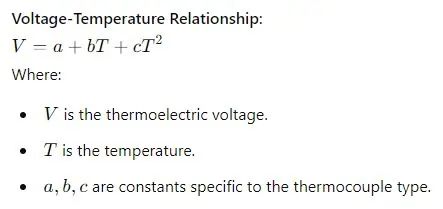
Pressure Sensor
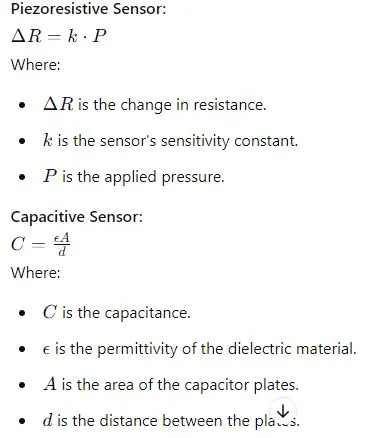
Light Sensor
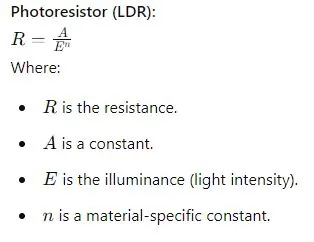
Position Sensor
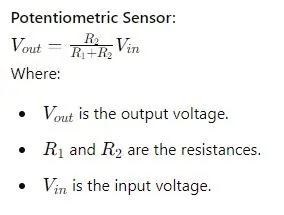
Motion Sensor
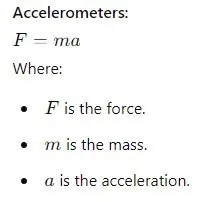
Advantages of Sensor
| Advantage | Description |
|---|---|
| Automation | Sensors enable automated control and monitoring of systems. They can perform tasks without human intervention, increasing productivity and reducing the likelihood of human error. This leads to more consistent and reliable operations across various industries. |
| Accuracy | Sensors provide precise measurements and monitoring. Their high sensitivity and specificity ensure that even minor changes in environmental conditions are detected, leading to better control and decision-making processes. |
| Efficiency | Sensors improve efficiency by enabling real-time data collection and analysis. This allows systems to respond promptly to changes, optimizing performance and reducing waste. Efficient systems can also lower operational costs and enhance overall productivity. |
| Safety | Sensors enhance safety in various applications by detecting hazardous conditions. They can identify potential risks such as gas leaks, fires, or equipment malfunctions early on, allowing for timely intervention and prevention of accidents or damage. This contributes to creating safer work environments and protecting both human and material resources. |
Challenges with Sensor
Calibration
Sensors require regular calibration to maintain accuracy. Over time, environmental factors, wear and tear, and other variables can cause sensors to drift from their original calibration settings. This drift can lead to inaccurate readings and unreliable data, which can compromise the performance of the systems relying on these sensors. Regular calibration ensures that sensors remain accurate and provide consistent, reliable measurements.
Environment
Sensors are sensitive to environmental conditions and may require protection. Factors such as temperature fluctuations, humidity, dust, and exposure to chemicals can affect sensor performance. For instance, moisture can cause corrosion in electronic components, and extreme temperatures can alter the properties of the materials used in sensors. Therefore, sensors often need protective housings and environmental controls to ensure their longevity and functionality.
Interference
Sensors are susceptible to electrical or magnetic interference, which can disrupt their operation and lead to inaccurate readings. This interference can come from various sources, including other electronic devices, power lines, and electromagnetic fields. To mitigate these effects, sensors may require shielding, filtering, and proper grounding. Designing systems to minimize interference is crucial for maintaining sensor accuracy and reliability.
Cost
High-precision sensors can be expensive. The cost of sensors can vary widely depending on their type, accuracy, and application. High-precision sensors, which offer greater accuracy and stability, often come at a higher price. This can be a significant investment, especially in large-scale applications where numerous sensors are needed. Balancing the need for accuracy with budget constraints is a common challenge in the design and implementation of sensor-based systems.
FAQ on Sensors
Q: What is a sensor?
A: A sensor is a device that detects and responds to physical changes in the environment, converting them into readable signals.
Q: Why are sensors important in automation?
A: Sensors enable automated control and monitoring of systems, increasing efficiency and reducing human error.
Q: What are common challenges with using sensors?
A: Common challenges include the need for regular calibration, sensitivity to environmental conditions, susceptibility to interference, and high costs for precision sensors.
Q: How do sensors enhance safety in various applications?
A: Sensors detect hazardous conditions early, allowing for timely interventions and preventing accidents or damage.
Conclusion
In today’s rapidly evolving technological landscape, sensors are indispensable. Their ability to detect and respond to a myriad of physical changes makes them critical components across various industries. From monitoring and controlling manufacturing processes in industrial automation to measuring vital signs in medical devices, sensors enhance precision, efficiency, and safety. In automotive systems, they ensure the smooth functioning of critical safety features, while in consumer electronics, they provide enriched user experiences through advanced functionalities.
The latest advances in sensor technology for 2024 promise to revolutionize these applications even further. Innovations in temperature, pressure, motion, and chemical sensors are paving the way for smarter, more responsive systems that can adapt to changing conditions in real-time. This transformative potential is particularly evident in marine applications, where sensors are vital for monitoring ship machinery, ensuring operational efficiency, and enhancing navigation safety.
Despite their numerous advantages, the deployment of sensors also presents challenges. Regular calibration is necessary to maintain their accuracy, and they must often be protected from harsh environmental conditions. Interference from electrical and magnetic sources can affect their performance, and high-precision sensors can be costly. However, the benefits they offer far outweigh these challenges, making them a worthwhile investment for any advanced system.
As we continue to innovate and develop new sensor technologies, staying updated with the latest advancements is crucial. Understanding the principles, applications, and challenges of sensors will enable engineers and professionals to design more effective, efficient, and safe systems. By leveraging the power of sensors, we can continue to push the boundaries of what is possible, driving progress and innovation across all sectors.
